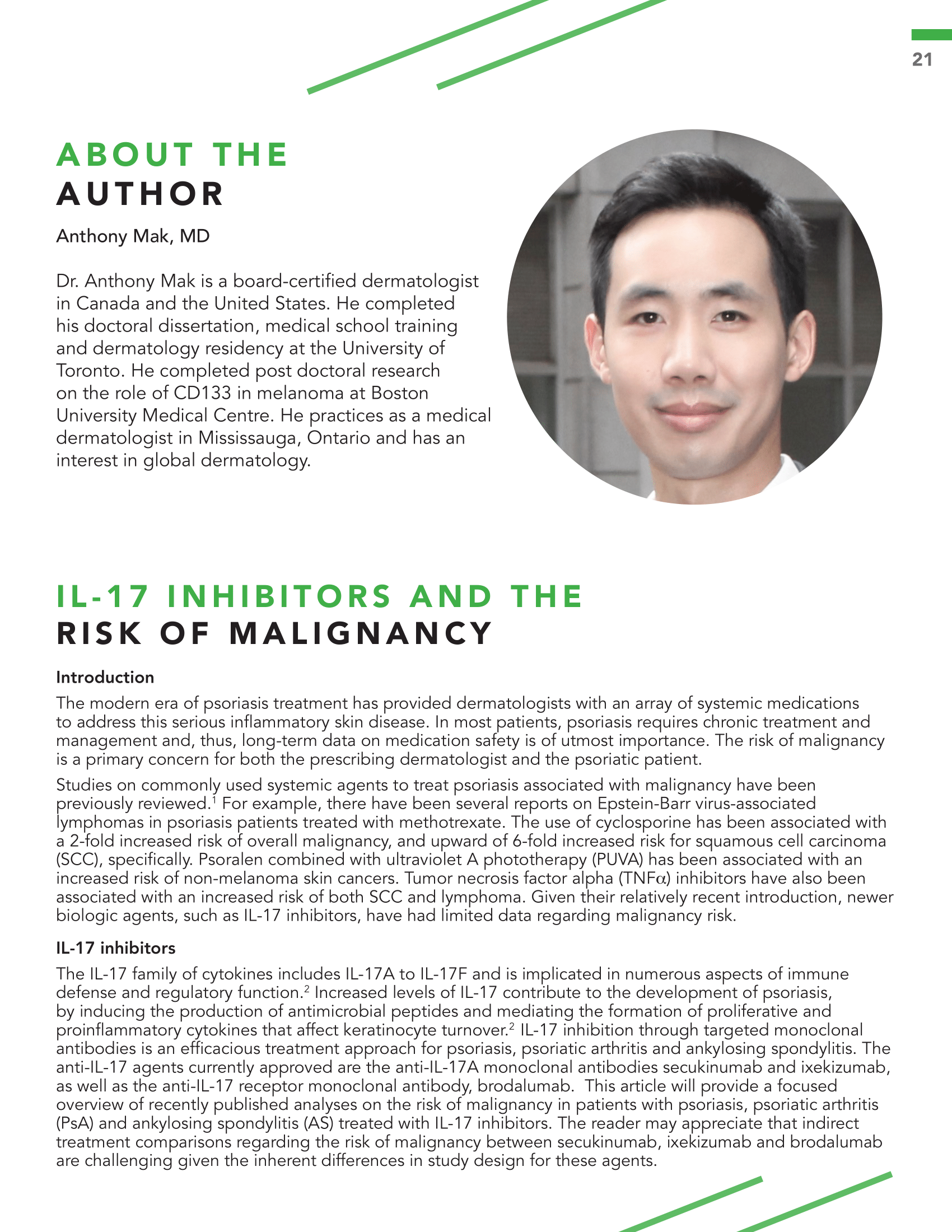IL-17 Inhibitors and the Risk of Malignancy
Abstract
The modern era of psoriasis treatment has provided dermatologists with an array of systemic medications to address this serious inflammatory skin disease. In most patients, psoriasis requires chronic treatment and management and, thus, long-term data on medication safety is of utmost importance. The risk of malignancy is a primary concern for both the prescribing dermatologist and the psoriatic patient.
Studies on commonly used systemic agents to treat psoriasis associated with malignancy have been previously reviewed. For example, there have been several reports on Epstein-Barr virus-associated lymphomas in psoriasis patients treated with methotrexate. The use of cyclosporine has been associated with a 2-fold increased risk of overall malignancy, and upward of 6-fold increased risk for squamous cell carcinoma (SCC), specifically. Psoralen combined with ultraviolet A phototherapy (PUVA) has been associated with an increased risk of non-melanoma skin cancers. Tumor necrosis factor alpha (TNFα) inhibitors have also been associated with an increased risk of both SCC and lymphoma. Given their relatively recent introduction, newer biologic agents, such as IL-17 inhibitors, have had limited data regarding malignancy risk.
References
Kaushik SB, Lebwohl MG. Psoriasis: Which therapy for which patient. Journal of the American Academy of Dermatology. 2019;80(1):27-40. doi:10.1016/j.jaad.2018.06.057
Berry SPD-G, Dossou C, Kashif A, et al. The role of IL-17 and anti-IL-17 agents in the immunopathogenesis and management of autoimmune and inflammatory diseases. International Immunopharmacology. 2022;102:108402. doi:10.1016/j. intimp.2021.108402
Lebwohl M, Deodhar A, Griffiths CEM, et al. The risk of malignancy in patients with secukinumab-ttreated psoriasis, psoriatic arthritis and ankylosing spondylitis: analysis of clinical trial and postmarketing surveillance data with up to five years of follow-up. British Journal of Dermatology. 2021;185(5):935-944. doi:10.1111/bjd.20136
Armstrong A, Paul C, Puig L, et al. Safety of Ixekizumab Treatment for up to 5 Years in Adult Patients with Moderate-to-Severe Psoriasis: Results from Greater Than 17,000 Patient- Years of Exposure. Dermatology and Therapy. 2020;10(1):133-150. doi:10.1007/s13555-019- 00340-3
Genovese MC, Mysler E, Tomita T, et al. Safety of ixekizumab in adult patients with plaque psoriasis, psoriatic arthritis and axial spondyloarthritis: data from 21 clinical trials. Rheumatology. 2020;59(12):3834-3844. doi:10.1093/rheumatology/keaa189
Gottlieb A, Lebwohl M, Liu C, Israel RJ, Jacobson A. Malignancy Rates in Brodalumab Clinical Studies for Psoriasis. American Journal of Clinical Dermatology. 2020;21(3):421-430. doi:10.1007/s40257-020-00512-4
Lebwohl M, Leonardi C, Wu JJ, et al. Two-Year US Pharmacovigilance Report on Brodalumab. Dermatology and Therapy. 2021;11(1):173-180. doi:10.1007/s13555-020-00472-x
Mastorino L, Dapavo P, Avallone G, et al. Biologic treatment for psoriasis in cancer patients: should they still be considered forbidden? The Journal of Dermatological Treatment. Published online August 30, 2021: 1-8. doi:10.1080/09546634.2021.1970706
Bellinato F, Gisondi P, Maurelli M, Girolomoni G. IL-17A inhibitors in patients with chronic plaque psoriasis and history of malignancy: a case series with systematic literature review. Dermatologic Therapy. Published online February 17, 2021. doi:10.1111/dth.14889


